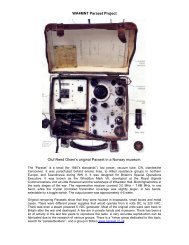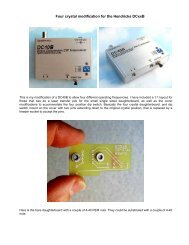Small Magnetic Loop Antenna Project - QRPBuilder.com
Small Magnetic Loop Antenna Project - QRPBuilder.com
Small Magnetic Loop Antenna Project - QRPBuilder.com
Create successful ePaper yourself
Turn your PDF publications into a flip-book with our unique Google optimized e-Paper software.
ground plane configuration, as well as the geometric form factor and physical proportions<br />
of the loop element itself are all fertile ground for experimentation. Various matching<br />
methods include series capacitor, transformer coupled subsidiary shielded-Faraday loop,<br />
and gamma-match, etc; each with their respective merits.<br />
The choice really boils down to personal preference as both the gamma and Faraday feed<br />
techniques work well. However, the Faraday shielded auxiliary loop located at the bottom<br />
central symmetry plane yields better loop electrical symmetry and balance that can in turn<br />
provide sometimes beneficial deeper front-to-side ratio and pattern nulls. In addition to<br />
imparting slight pattern asymmetry the Gamma match method can also result in some<br />
deleterious <strong>com</strong>mon-mode current flow on the outer braid of the feed coax that might need<br />
choking-off and isolating with ferrite decoupling balun to prevent spurious feeder radiation<br />
and extraneous noise pick-up on Rx. Much also depends on the site installation set up in<br />
respect of conductive objects in the loop’s near field that can disturb symmetry.<br />
With the elegantly simple transformer-coupled Faraday loop feed method the 50Ω signal<br />
source merely feeds the auxiliary loop; there’s no other coupling / matching <strong>com</strong>ponents<br />
required as there are no reflected reactive <strong>com</strong>ponents to deal with (the main loop appears<br />
purely resistive at resonance with just the core Rrad and Rloss <strong>com</strong>ponents in series).<br />
The impedance seen looking into the auxiliary feed loop is determined solely by its<br />
diameter with respect to the primary tuned resonator loop. A loop diameter ratio of 5:1<br />
typically yields a perfect match over a 10:1 or greater frequency range of main loop tuning.<br />
Simple transformer action occurs between the primary loop and the feed loop coupled<br />
circuit due to the highly reactive field near the resonant primary loop which serves to<br />
greatly concentrate magnetic flux lines which cut the small untuned feed loop. The degree<br />
of magnetic flux concentration is a function of the Q of the tuned primary which varies<br />
with frequency, i.e. the highest Q occurring at the lowest frequency of operation and the<br />
lowest Q exhibited at the highest frequency. This variation in Q results from the variation<br />
in the sum of the loss resistance and the <strong>com</strong>plex mode radiation resistances of the primary<br />
radiator loop as a function of frequency. The effective feed impedance of the secondary<br />
loop is controlled by its diameter / ratio of area and by the number of flux lines cutting it;<br />
thus the impedance seen looking into the secondary loop will be essentially independent of<br />
frequency. One can intuitively see this because when the feed loop is extremely small in<br />
relation to a wavelength at the lowest frequency of operation, the number of magnetic flux<br />
lines cutting it is large because of the very high Q, whereas when the feed loop be<strong>com</strong>es a<br />
larger fraction of a wavelength as the frequency of resonance is increased, the<br />
concentration of flux lines is reduced due to the lower Q.<br />
If one seeks mode purity and figure-8 pattern symmetry with deep side nulls, the fully<br />
balanced Faraday transformer coupled subsidiary broadband impedance matching loop<br />
with its 5:1 diameter ratio would be the preferred choice of feed structure.<br />
<strong>Loop</strong> balance is also important for rejecting local electric E-field conveyed noise; whereas<br />
the small loop is predominantly H-field responsive, any electrical imbalance results in<br />
<strong>com</strong>mon-mode currents on the feeder that will impart deleterious E-field sensitivity which<br />
may contribute to additional local noise pickup. That inherent loop imbalance and<br />
asymmetry is one of the slight trade-offs associated with a Gamma feed <strong>com</strong>pared to an<br />
auxiliary Faraday loop transformer feed. This aberration is not an issue with Tx mode of<br />
course.<br />
3





